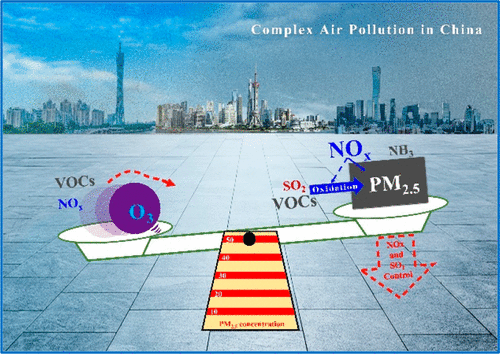当前位置:
X-MOL 学术
›
Environ. Sci. Technol. Lett.
›
论文详情
Our official English website, www.x-mol.net, welcomes your
feedback! (Note: you will need to create a separate account there.)
Air Pollutant Correlations in China: Secondary Air Pollutant Responses to NOx and SO2 Control
Environmental Science & Technology Letters ( IF 8.9 ) Pub Date : 2020-07-23 , DOI: 10.1021/acs.estlett.0c00403 Biwu Chu 1, 2, 3 , Qingxin Ma 1, 2, 3 , Jun Liu 1, 3 , Jinzhu Ma 1, 2, 3 , Peng Zhang 1 , Tianzeng Chen 1 , Qingcai Feng 1 , Chunying Wang 4 , Na Yang 4 , Hongnan Ma 4 , Jingjin Ma 4 , Armistead G. Russell 5 , Hong He 1, 2, 3
Environmental Science & Technology Letters ( IF 8.9 ) Pub Date : 2020-07-23 , DOI: 10.1021/acs.estlett.0c00403 Biwu Chu 1, 2, 3 , Qingxin Ma 1, 2, 3 , Jun Liu 1, 3 , Jinzhu Ma 1, 2, 3 , Peng Zhang 1 , Tianzeng Chen 1 , Qingcai Feng 1 , Chunying Wang 4 , Na Yang 4 , Hongnan Ma 4 , Jingjin Ma 4 , Armistead G. Russell 5 , Hong He 1, 2, 3
Affiliation

|
PM2.5 concentrations have decreased remarkably in China in recent years, coinciding with a more rapid decrease in SO2 concentrations and a slower decrease in NO2 concentrations, while O3 concentrations increased. Correlations between PM2.5 and key gaseous pollutants were studied to identify linked trends as a means of understanding the impacts of air pollution control in China. In most cities, the PM2.5–NO2 correlation coefficients were higher than the PM2.5–SO2 correlation coefficients, and the gap tended to expand as air quality improved. Multiple linear regression also indicated that PM2.5 concentrations were more sensitive to changes in NO2 than in SO2. The rate of decrease in the PM2.5 concentration with a decreasing NO2 concentration is nearly 3 times higher than that with SO2. These results support the priority of controlling NOx to further reduce PM2.5 pollution in China. The chemistry behind this was twofold: (1) NOx can be converted into nitrate, and (2) NOx contributes to atmospheric oxidation capacity. The decrease in PM2.5 concentration always coincided with an increase in O3 concentration when the PM2.5 concentration was higher than 50 μg m–3. However, the correlation between PM2.5 and O3 tended to change from negative to positive as air quality improved, indicating O3 and PM2.5 control could both benefit from reducing the concentrations of gas precursors.
更新日期:2020-07-23











































 京公网安备 11010802027423号
京公网安备 11010802027423号